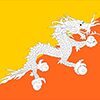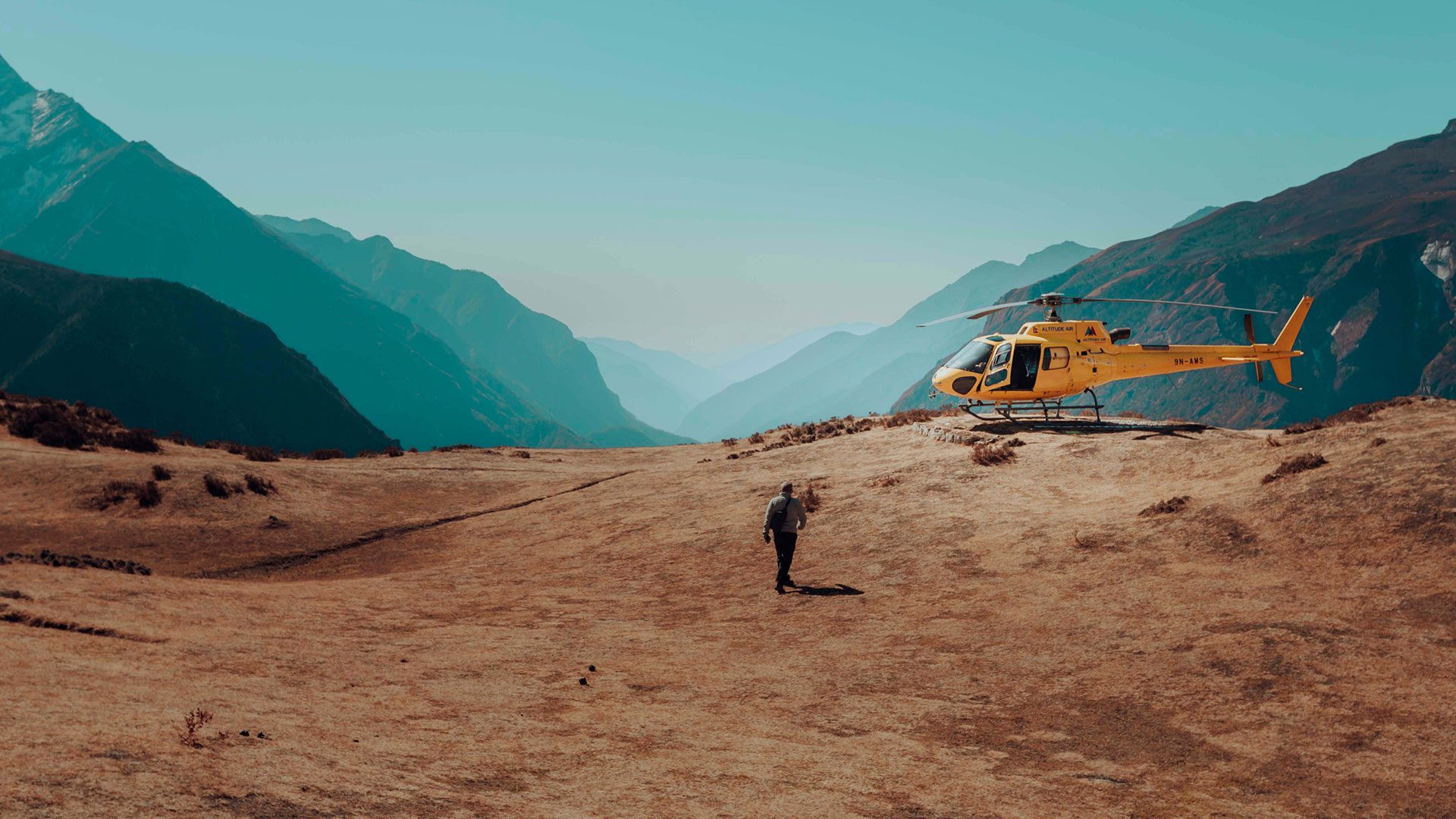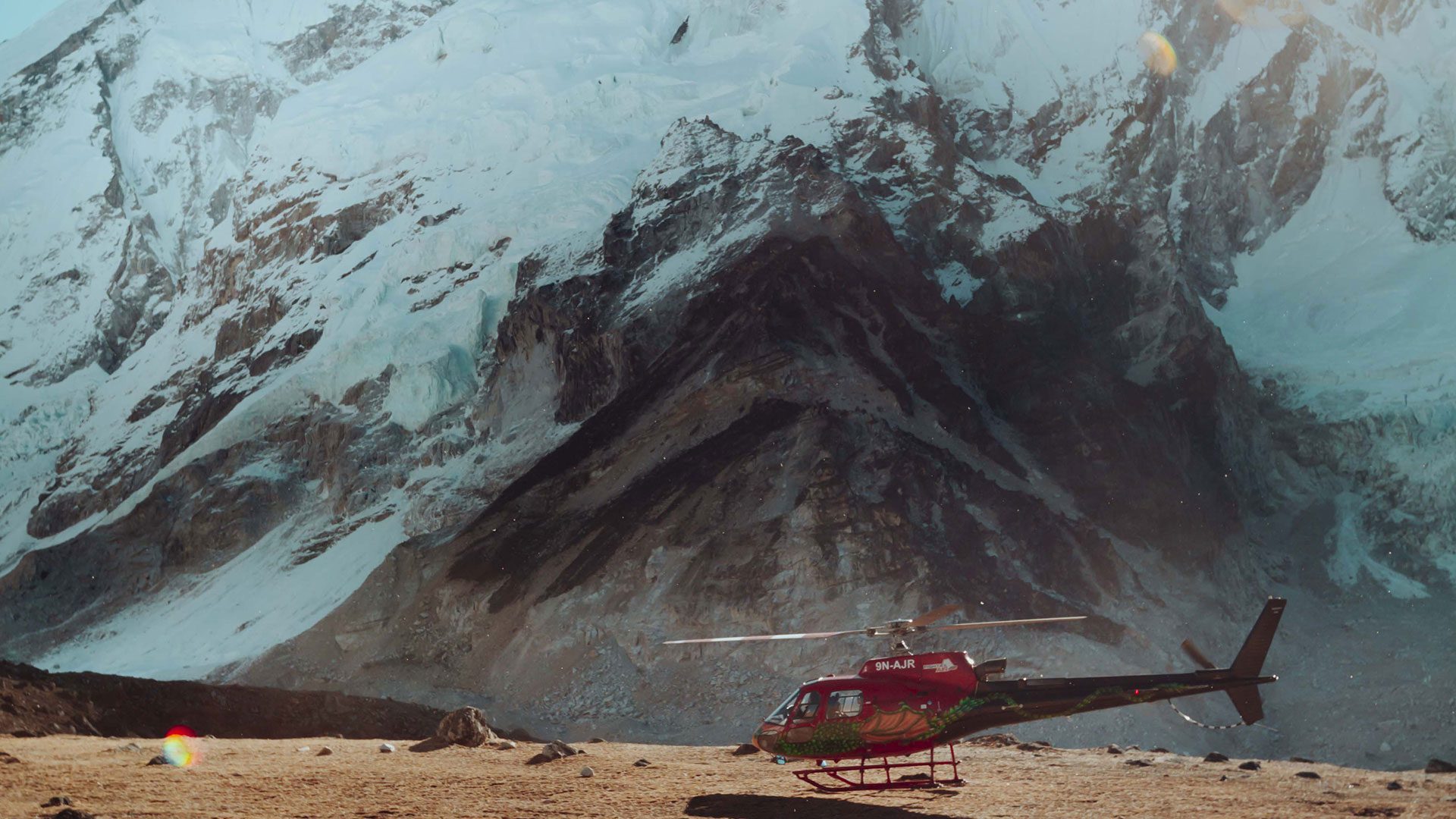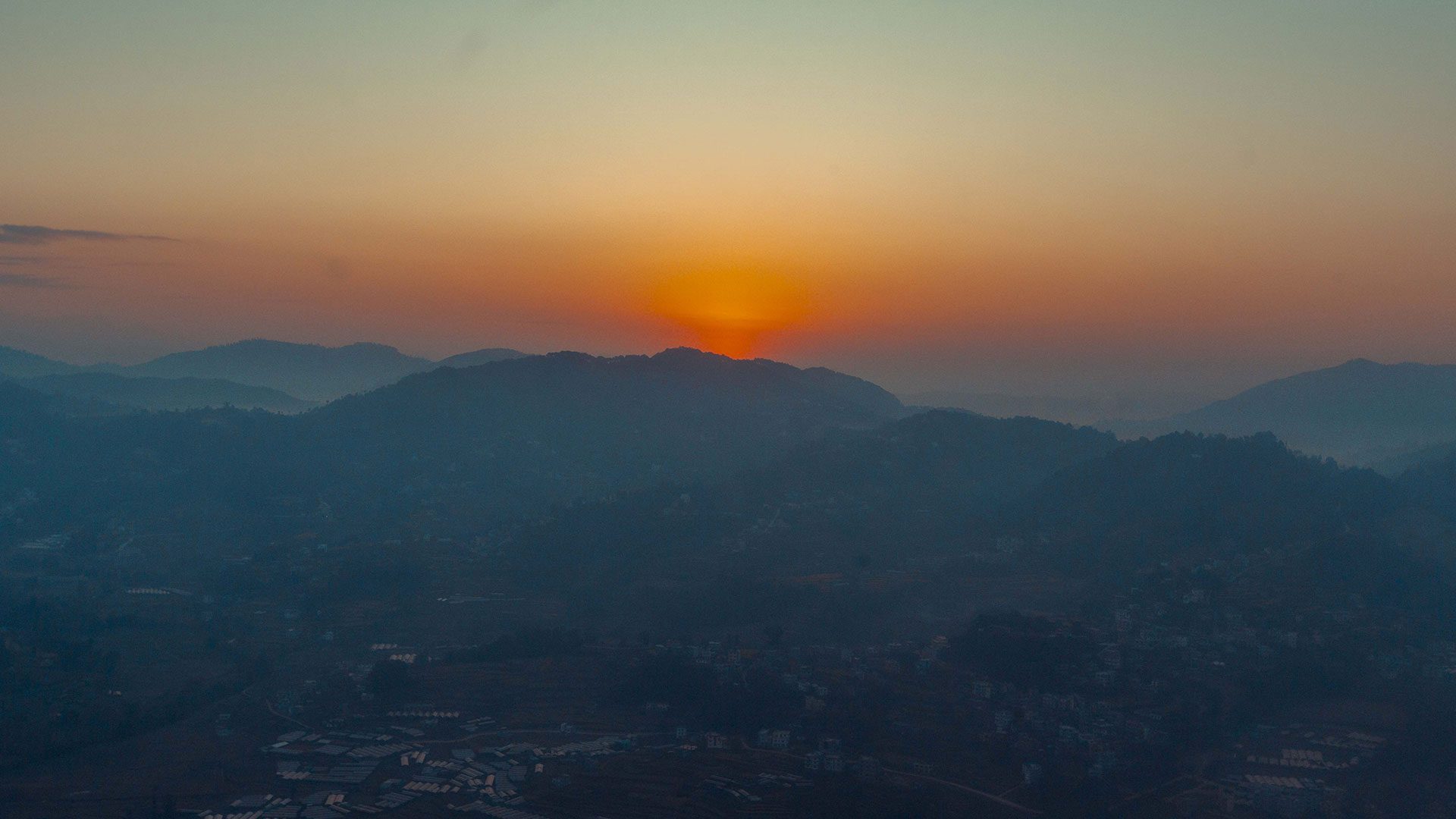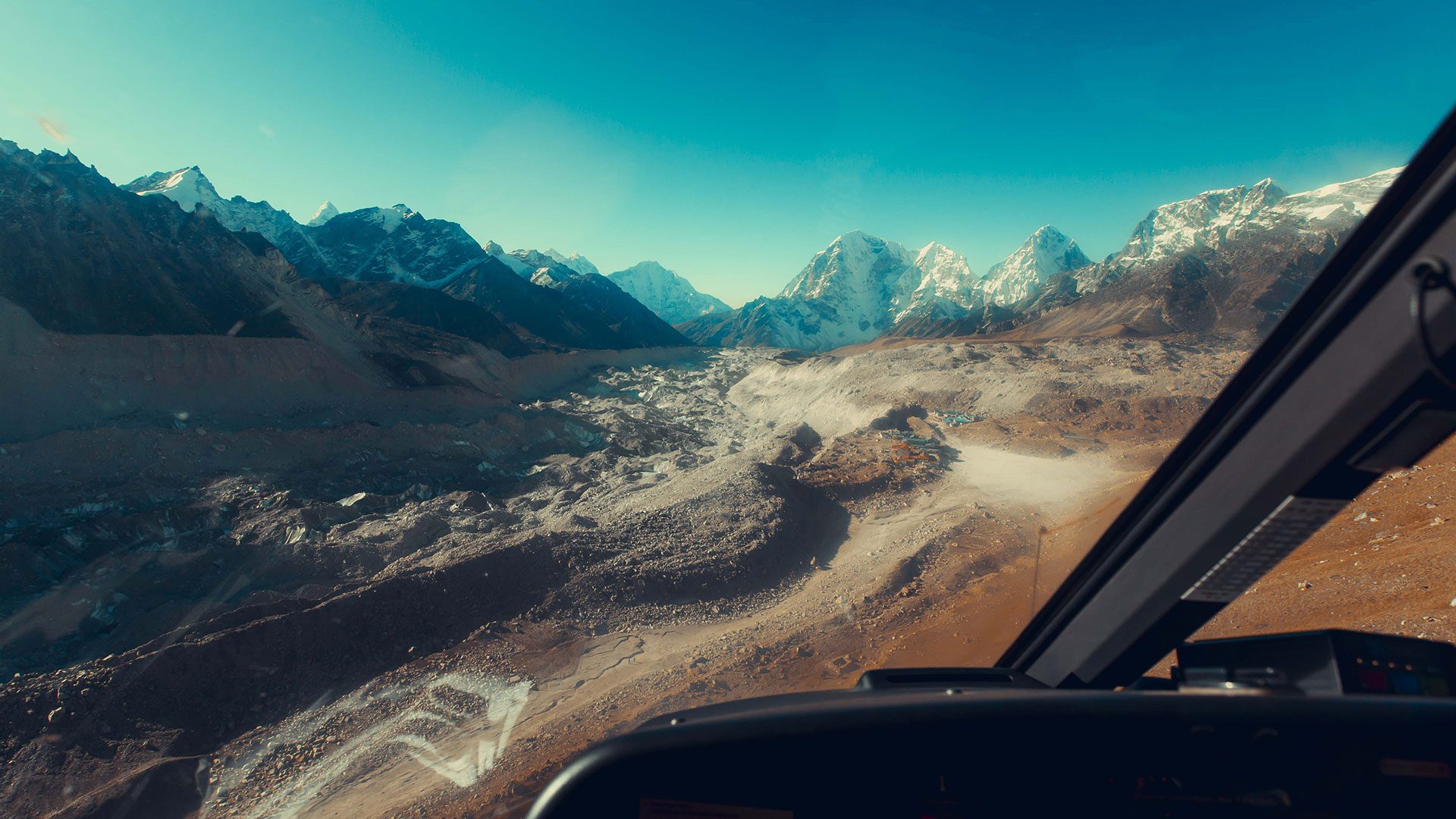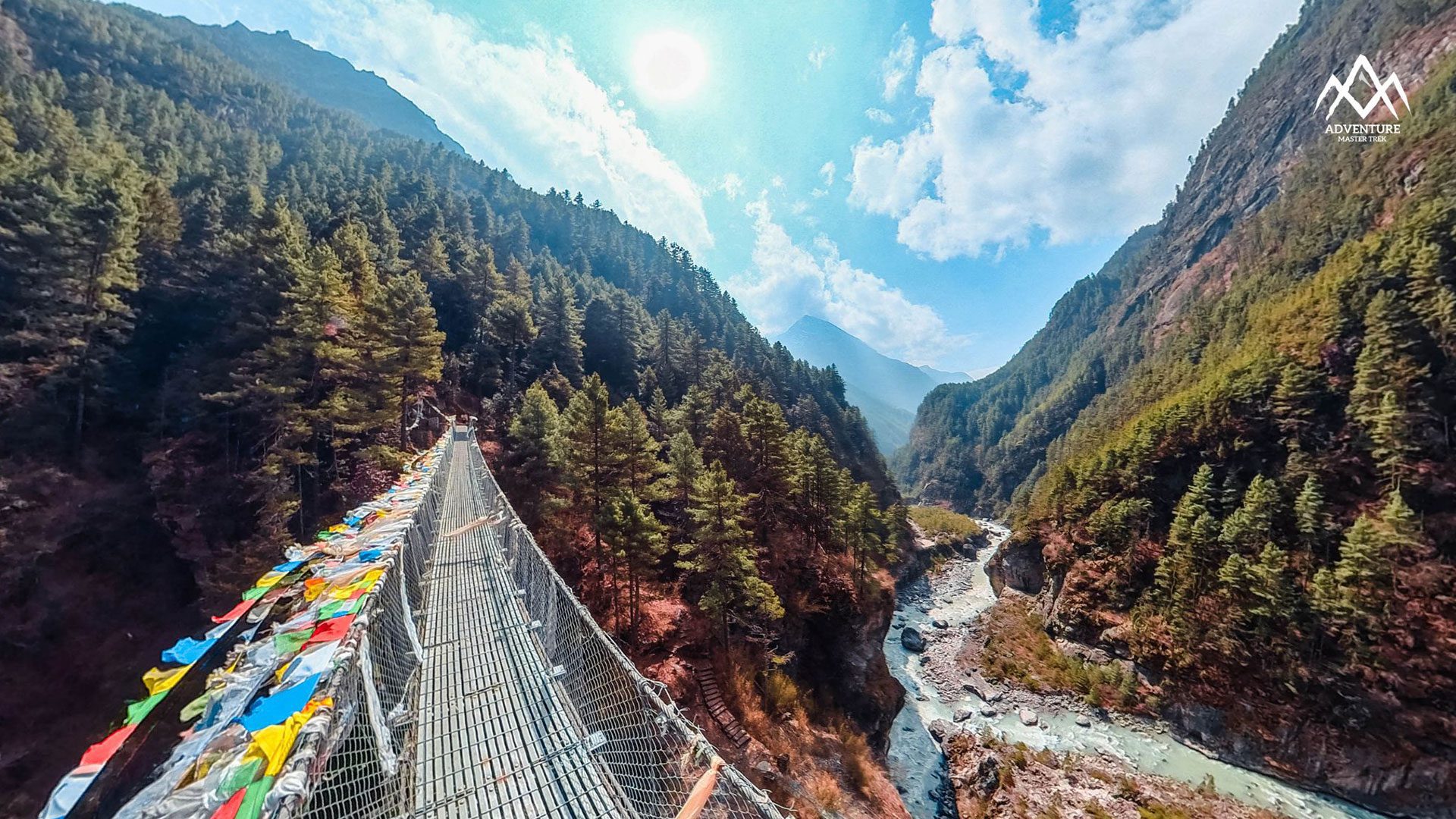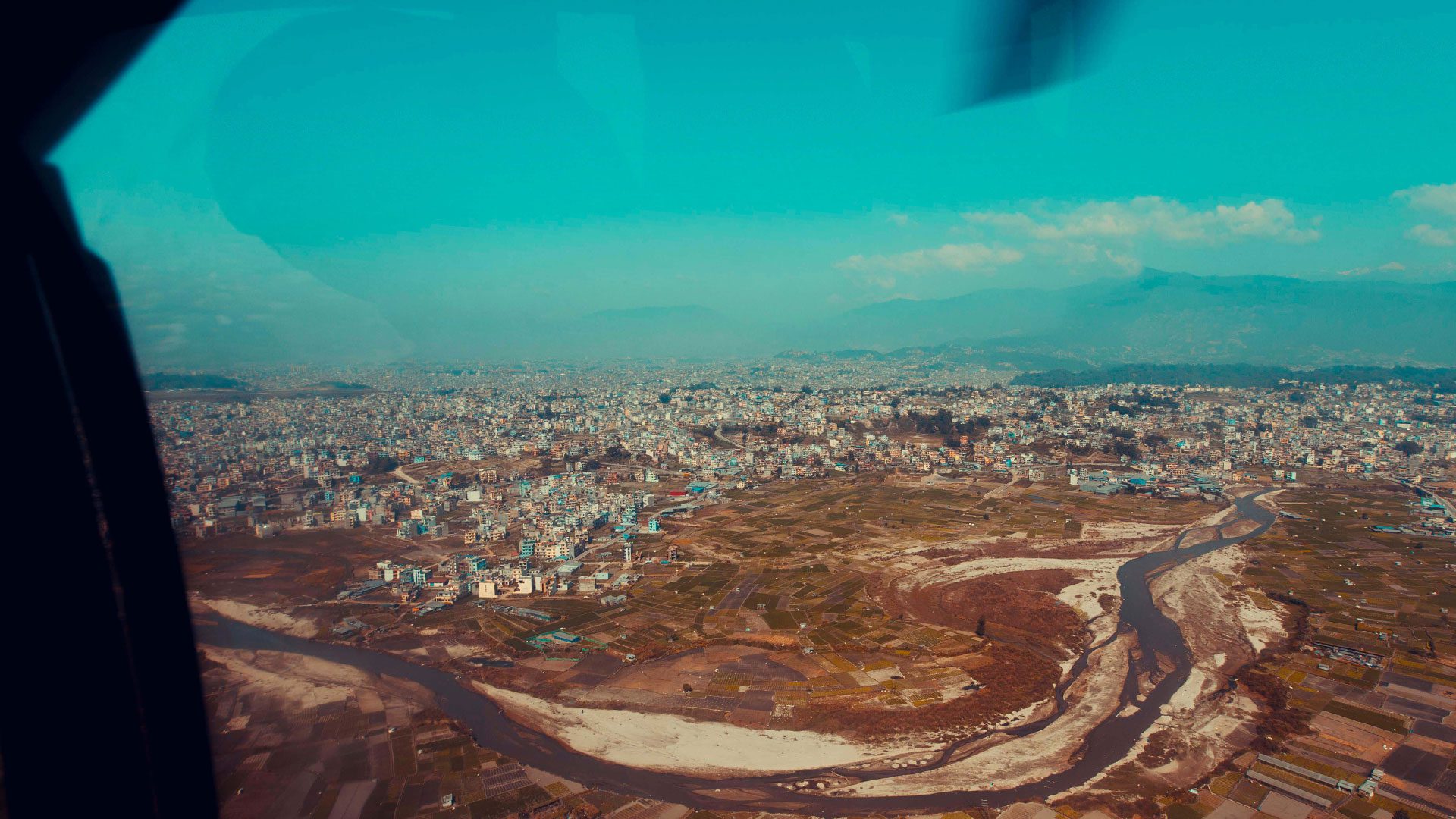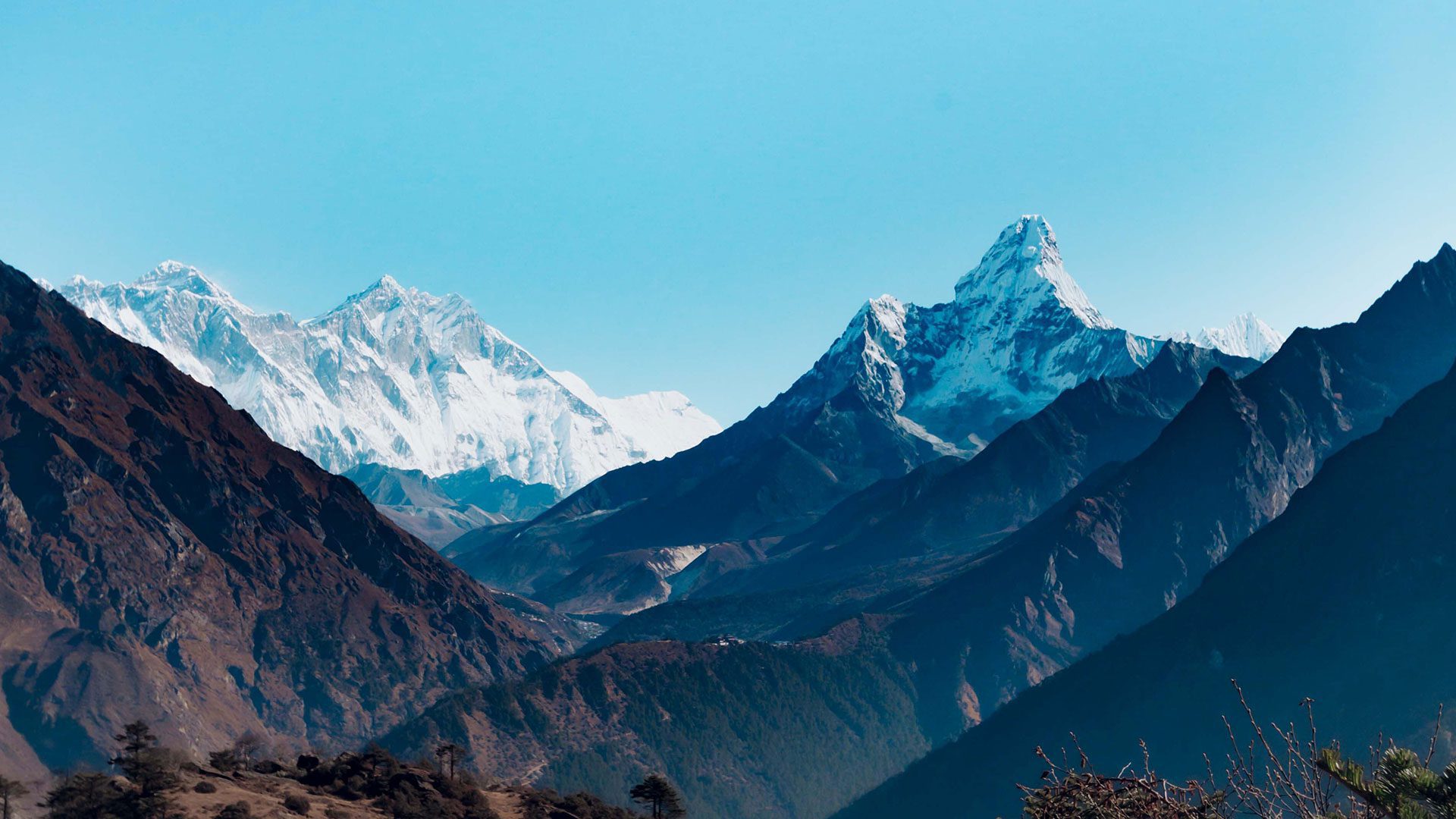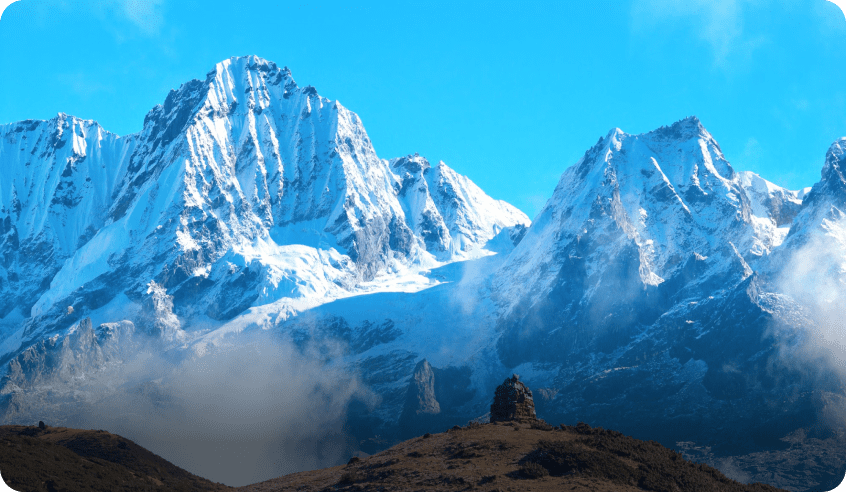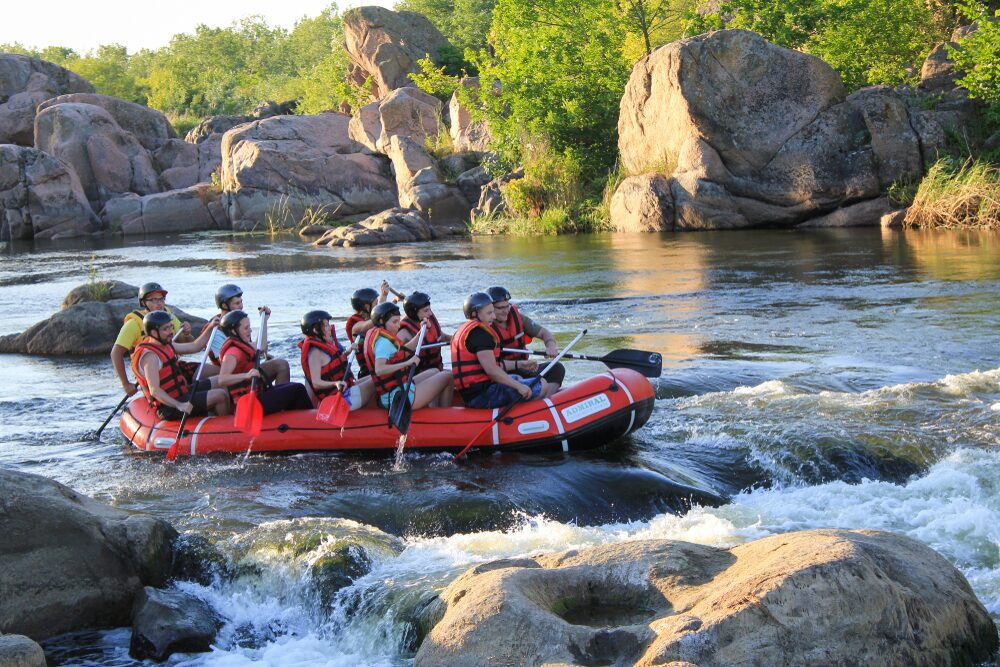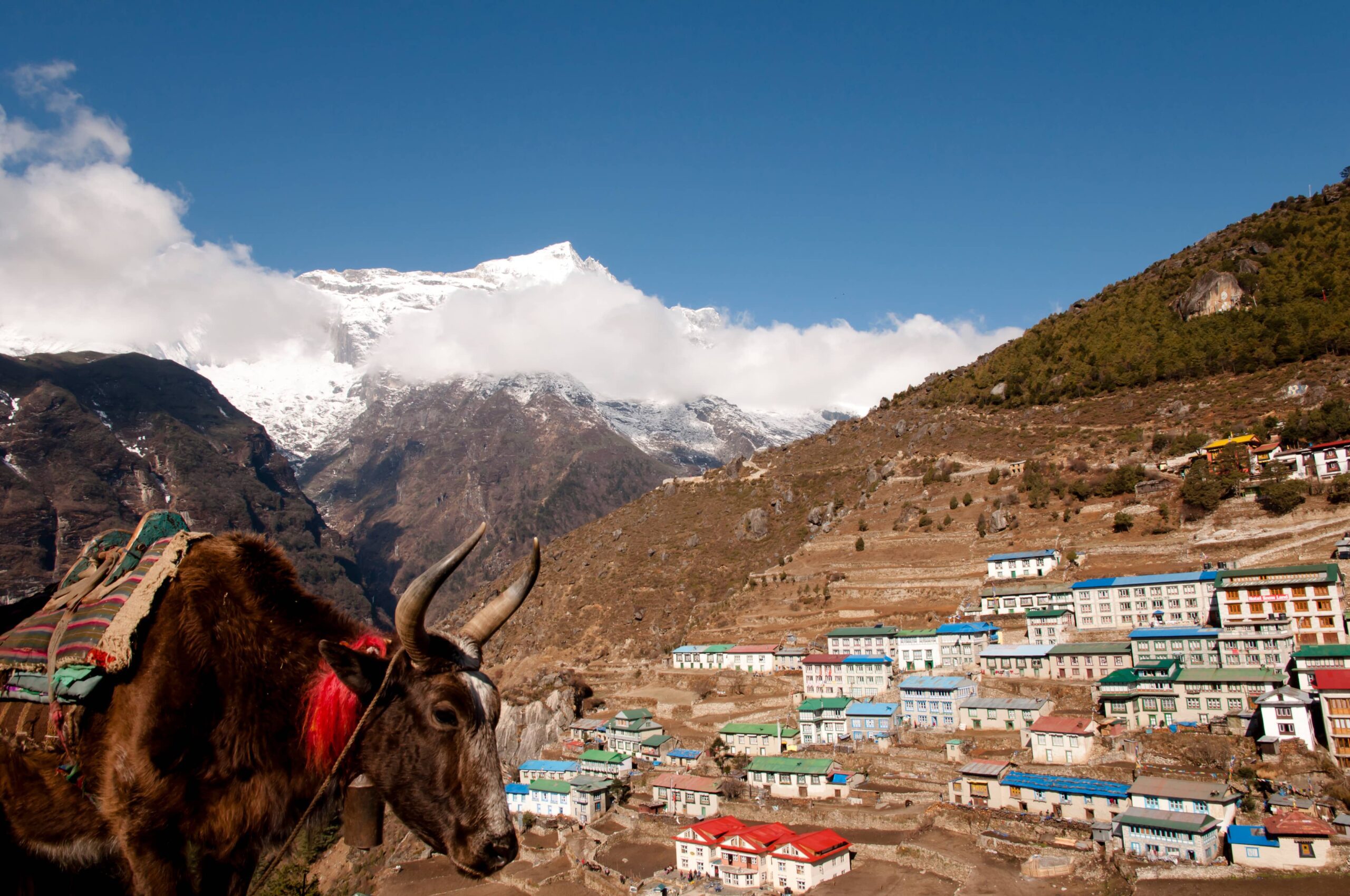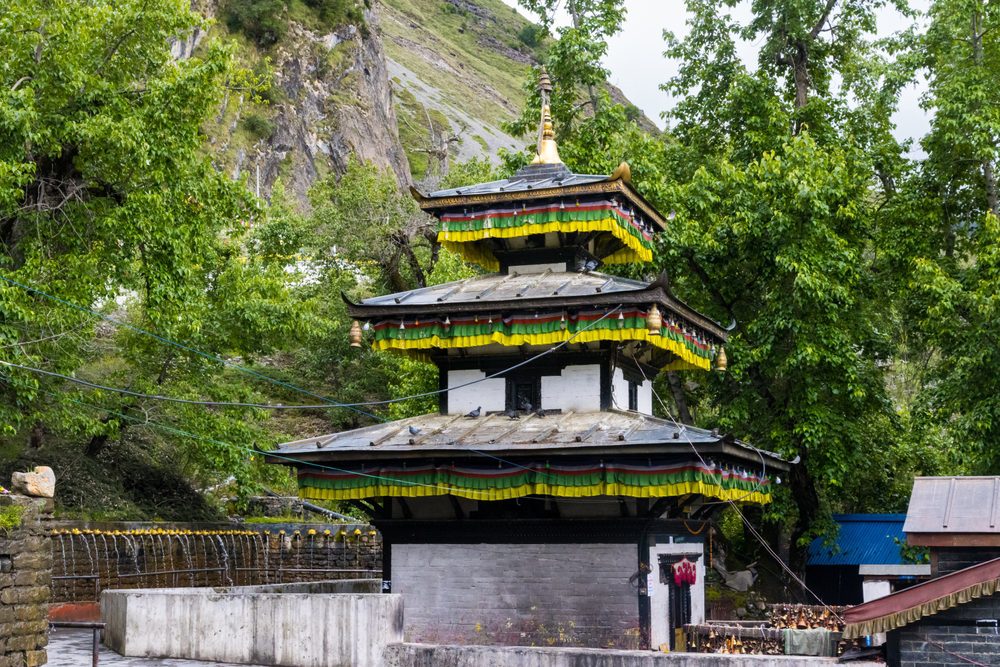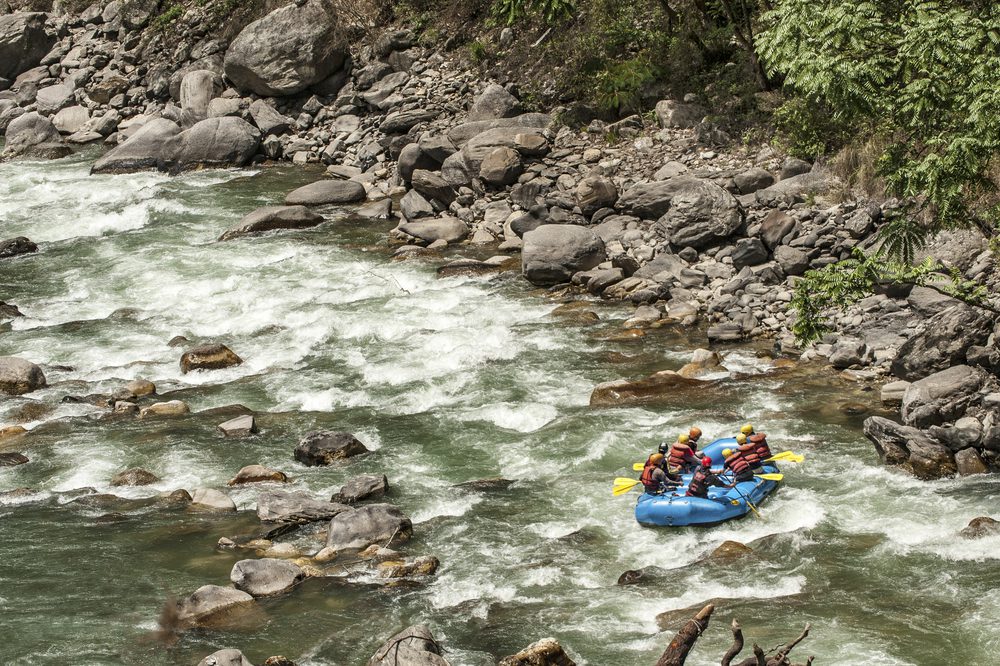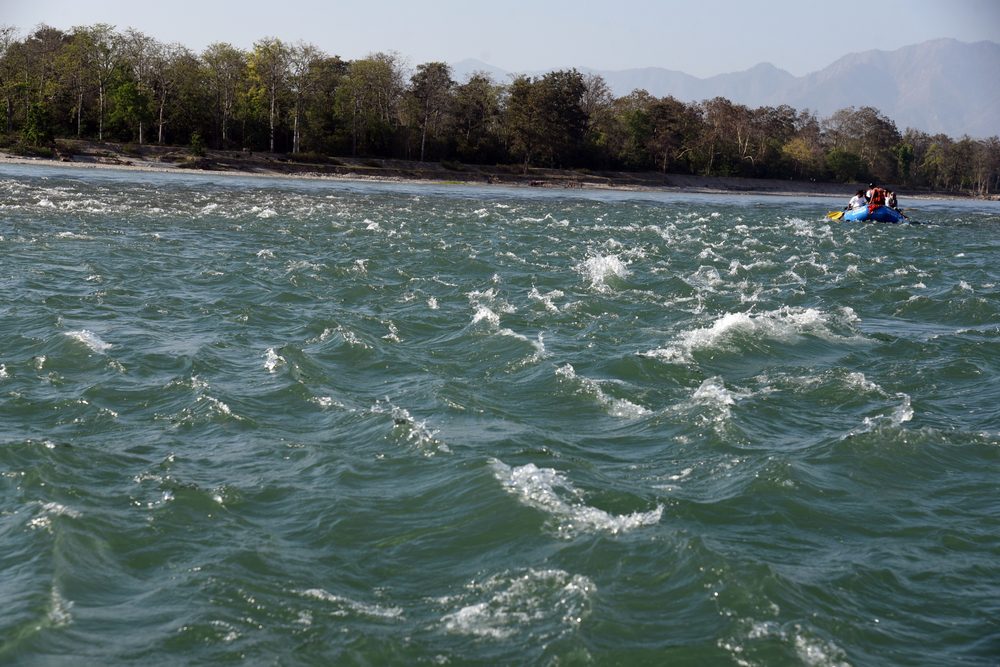Everest Base Camp Helicopter Return Trek
5(32)
Trip Facts
Everest Base Camp Helicopter Return Trek Overview
The combination of a trek with a helicopter return makes the Everest Base Camp Helicopter Return Trek both luxurious and adventurous at the same time. The Everest region can be fully appreciated through the helicopter ride, as well as through the trek on foot. This wonderful 9-day trek takes its participants through the core parts of the Khumbu region. You get to see the breathtaking Himalayas, the hardworking Sherpas, and even the popular Namche Bazaar, Tengboche Monastery, and Everest Base Camp. All these things truly make Sherpa culture stand out.
The trek begins with a scenic flight from Kathmandu to Lukla, features a leisurely great height gain through Phakding, Namche Bazaar, Tengboche, Dingboche, and Lobuche all the way to Everest Base Camp. Trekkers are provided with sufficient time as they ascend for serenity acclimatization, which also includes a hike to the impressive Everest View Hotel. In my opinion, the best part of an expedition towards Everest Base Camp is a daring and brisk walk towards the first vantage point of Mount Everest, Kala Patthar, which provides a breathtaking view of the peak’s sunrise.
Instead of retracing the same trekking route back, the return journey is completed in style with a thrilling helicopter flight from Gorak Shep to Lukla and then to Kathmandu, offering breathtaking aerial views of the Himalayas. This trek is suitable for travellers who aim to capture some of the finest views of Mount Everest, without the extensive forward trek sequence, thus making a thrilling and once-in-a-lifetime fusion of comfort and challenge that is perfect for any traveller.
Trip Highlights
- Enjoy a thrilling flight with stunning views of the Himalayas as you approach the famous Lukla airport.
- Trek through iconic Sherpa villages.
- Experience the culture and hospitality of local Sherpa communities in Phakding, Namche Bazaar, Tengboche, Dingboche, and Lobuche.
- The dreamiest sunrise views of Mount Everest and Mount Lhotse and the snow-capped Himalayan mountains.
- Taking a helicopter from Gorak Shep to Lukla transforms into a unique experience.
- Get stunning aerial views of the valleys and the mountains like Ama Dablam, Lhotse, Cho Oyu, and Pumori.
- Not only do you save energy by taking a helicopter, but you also are able to greatly appreciate the scenery offered in the region.
- Experience the insightful Sherpa culture, and discover places like the Tengboche Monastery and the Everest View Hotel.
9 Days Everest Base Camp Helicopter Return Trek Itinerary
Your Journey, Step by Step
Flight from Kathmandu to Lukla airport (2,846 m/9,337 ft) and trek to Phakding (2,610 m/8,563 ft)
An early morning scenic flight to Lukla (2,846 m/9,337 ft) marks the beginning of your Himalayan adventure. This is a 30-35 minute flight that offer stunning views of snow-capped peaks before landing.
After meeting your porters and organizing gear, the trek officially starts with a gentle descent through pine forests and Sherpa villages. You will pass along the Dudh Koshi River crossing suspension bridges draped in prayer flags. The Passing through charming villages like Chheplung and Ghat, you’ll arrive at Phakding (2,610 m/8,563 ft), a riverside village where you’ll spend your first night on the trail. This is a short trek perfect for acclimatization and getting used to the altitude.
Trek from Phakding to Namche Bazaar (3,440 m/11,290 ft)
Today’s trek goes deeper into the Khumbu region with a mix of easy and hard climb. After trekking for about 5 km, you’ll reach Monjo. Starting from Monjo, you will begin passing through Sagarmatha National Park with views of Tharmasarku peaks. Afterwards, head towards Jorsalle, where you will be able to register your permits. Here, you will find the path that slopes up the river towards the famous Hillary Suspension Bridge.
During the last stage, the only remaining task will be to climb up hill through a combination of dense tree forests and hairpin bends. Despite the difficulty in the final climb, the view from the top offers an amazing reward where you will find yourself in Namche Bazaar, a vibrant town settled on a steep hillside. It is the administrative and commercial hub of the Everest region and at the same time is full of teahouses, bakeries, and trekking stores, which makes it an ideal location to rest before heading to more challenging parts of the trek.
Acclimatization in Namche Bazaar: hike to Syangboche Airstrip (3,748 m/12,297 ft) and Everest View Hotel (3,962 m/13,000 ft)
Day 4 of the nine-day Everest Base Camp trek is a chance to recover from the hike and ponder upon the stunning views that surround you. Today’s pace is measured, giving the legs a chance to recuperate and allowing you to take in all that you’ve witnessed thus far. For successful trekking at higher elevations, proper acclimatization is essential, so you’ll get to take short hikes to let everything settle.
The trail ascends to the Syangboche Airstrip (3,748 m/12,297 ft); the views at the top of the airstrip are incredibly jaw-dropping. From a little further away, the Everest View Hotel (3,962 m/13,000 ft) can be spotted, which happens to be one of the most luxurious hotels at such high elevations. It is one of the highest luxury hotels in the world, from where one can capture their first panoramic view of Mount Everest, Lhotse, Ama Dablam, along with other superb Himalayan mountains.
You can also opt to go to Khumjung Village, which has the Hillary School and a monastery that possesses a yeti scalp. After a view and an excursion, on your way back to Namche, a town that has been set up for trekkers, gives you a chance to spend the evening at rest. This prepares you well for the higher altitudes that your trekking goes toward next.
Trek from Namche Bazaar to Tengboche/Dibuche (3,860 m/12,660 ft)
On this day, you can expect wonderful views of snow-covered peaks and green valleys as you make trekking through the stunning Khumbu region. This area has droning trails of its own which contain both gradual descents and steep climbs, weaved through dense forests. They are filled with beautiful rhododendrons, along with astonishing mountain views. While you travel in the direction of either Tengboche or Dibuche(3,860 m/12,660 ft), you will pass by gorgeous villages, alongside suspension bridges which soar high above raging rivers beneath.
One of the highlights for today is a possible visit to the exceedingly famous Tengboche Monastery, located at the very center of some of the most important spiritual sites in the Everest region. Here, breathtaking views can be obtained as well as trekkers get the opportunity to take part in Buddhist practices throughout the charming atmosphere. To wrap up the day, we will spend an overnight rest in Tengboche or Dibuche, which will give us stunning views of the Himalayas.
Trek from Tengboche/Dibuche to Dingboche (4,410 m/14,470 ft)
As you continue trekking and climbing, you’ll see the stunning height of the glacial valley, and towering peaks around you. The trek passes the small Sherpa settlements and alpine meadows and slowly increases in altitude, working its way to Dingboche which sits at 4,410 meters or 14,470 feet.
When you reach Dingboche, your energy will be at rest, and you will be fully acclimated to the serene surroundings of this village. Your body will be ready for the higher altitude conditions. Your body will acclimate over time. You’ll sleep in Dingboche for the night, nestled under the peak of the towering summits.
Trek from Dingboche to Lobuche (4,940 m/16,210 ft)
The seventh day, the trek becomes a bit challenging as the altitude increases. It requires a steady pace and proper acclimatization. Trek to Lobuche village (4,940m/16,210ft) starts from Dingboche and offers a breathtaking view of towering peaks such as Ama Dablam and Thamserku. You have to navigate through some alpine terrain and travel across glacial moraines in harsh, highland scenic spots, which is becoming tougher as the altitude increases.
On the way, you can visit the memorial site at Thukla Pass and pay tribute to the climbers who have died in the Himalayas. The trek is very demanding due to thinner air, which requires a lot of effort, but there are lots of effort, but there are lots of places to stop and take in the fantastic views. After a journey through Obluche, which is a small village tucked in amongst rugged slopes, you can take some rest for the next stage of the journey for a night in the cool mountain air.
Trek from Lobuche to Everest Base Camp (5,364 m/17,598 ft) via Gorak Shep (5,164 m/16,942 ft) and back to Gorak Shep for a night’s stay
Today is one of the toughest and most memorable days of your trek. Most trekkers face this stretch on the 8th day. The trek starts from Lobuche to Gorak Shep (5,164 m/16,942 ft) which is the last village before the base camp. The landscape becomes more rugged, barren and dominated by glacial moraines. You have to push hard and steady, aware of the thin air and high altitude. You will see the stunning views of some of the highest peaks in the world including Pumori, Nuptse and Mount Everest itself.
After a short rest and refuel at Gorak Shep the adventure continues to Everest Base Camp (5,364 m/17,598 ft) a place of great historical and mountaineering importance. After observing the spectacles of the Khumbu Icefall and exploring the base camp, we set off back to Gorak Shep. Although exhausted, the sense of achievement really helps on the walk back, and once they make it. Now we prepare to stay overnight at Gorak Shep and rest beneath the magnificent Himalayan mountains.
Hike to Kala Patthar (5,644 m/18,519 ft) early in the morning, coming back to Gorak Shep, and take a helicopter flight back to Lukla and flight back to Kathmandu
Today is the last day of the trek, we wake up early to get a head start on the hike to Kala Patthar (5,644m/18,519ft) one of the most popular viewpoints. The golden hour during sunrise makes it magical, and during these moments, we get to see Nuptse, Lhotse, Everest and Pumori. We will return to Gorak Shep feeling sore from the views left in our minds.
A helicopter flight from Gorak Shep to Lukla will give us a thrilling and scenic descent and we will bypass the long trek down. From Lukla, another helicopter will take us back to Kathmandu, and the trip will conclude. Today is the end of the adventure in the Everest region and we will be left with the memories of one of the most beautiful and toughest landscapes in the world.
Customize this trip with help from our local travel specialist that matches your Interests.
Customize This Trip
Everest Base Camp Heli Return Trek Inclusions
What’s Covered in Your Adventure
- All airport transfers, which include all land travel, are conducted using a private vehicle.
- Breakfast is included with the accommodation package for a three-star hotel in Kathmandu for two nights (follows the itinerary).
- Flight from Kathmandu to Lukla and back.
- During the trek, you will be provided with three meals a day: breakfast, lunch, and dinner with one cup of tea each meal.
- You will stay at a hotel or lodge of your choice.
- A highly experienced, helpful, knowledgeable, friendly, English-speaking guide with all of his salary, food, drinks, lodging, transportation, and insurance covered.
- A strong helpful Sherpa porter with his food, salary, insurance, Gear, all covered (one potter for two people ) Gorakshep to Lukla by helicopter.
- Certificate of completion for the journey.
- All papers that need to be done, Fees for entering permits you need to go while hiking.
- Only coverage for helicopter insurance can be provided.
- Government taxes and office fees.
- In case of an emergency, an oximeter is included to monitor the trekker's pulse, oxygen saturation, and heart rate to detect signs of Altitude Mountain Sickness, or AMS when the trekker is above a certain altitude. This will make sure that your trek is in the safest hands possible, no matter how experienced you are.
- Lunch and Dinner you will have in Kathmandu.
- A Visa to enter Nepal will cost you $30 USD for a stay of 15 days, $50 for 30 days, and $125 for 90 days.
- Travel and medical insurance.
- Other personal or miscellaneous expenditures.
- All drinks, both alcoholic and non-alcoholic, that you buy while trekking (including those that you buy in the Tea Houses at night).
- Gratitude for the guide, the porter, and the driver. (Tipping is expected.)
- International airfares.
- All sweet desserts that are available, such as chocolate, cake, pie, and pudding.
- The hot showers and charging stations for your phone are available at the tea houses and will cost you about 2- 5 USD.
Trek Maps/ Elevation
Navigate Your Journey
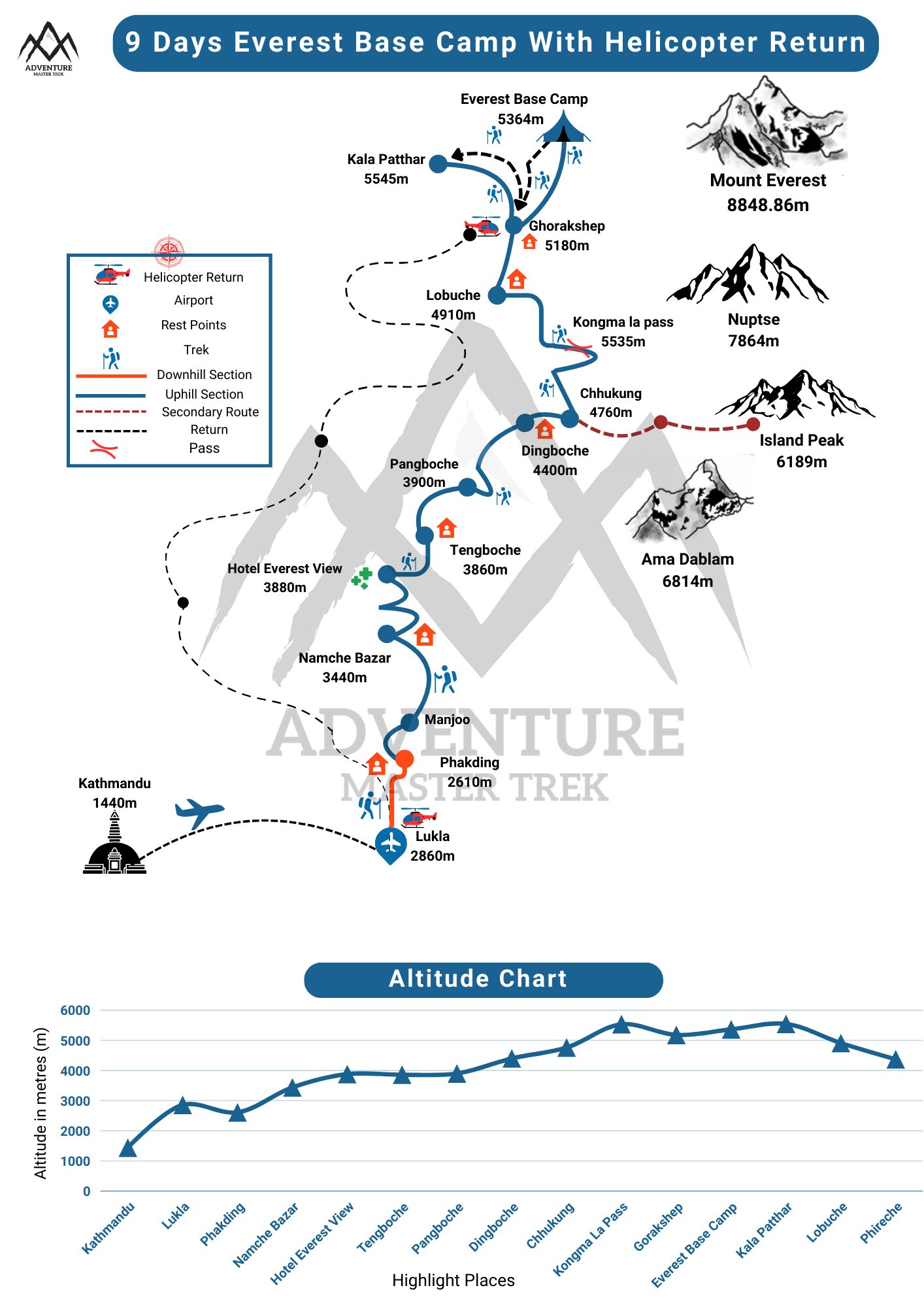
Useful Information for EBC Heli Return Trek
Know Before You Go
Trek Difficulty for EBC with Heli Return
The Everest Base Camp Trek with a helicopter return, especially on a condensed 9-day itinerary like this, is rated as challenging to strenuous. Here’s why:
Altitude Sickness due to High Altitude
Altitude poses the most significant challenge on this trek, as you will ascend rapidly to extreme elevations with limited time for acclimatization. The journey begins in Lukla at 2,846 meters (9,337 feet), followed by a climb to Namche Bazaar at 3,440 meters (11,290 feet). The route culminates at Everest Base Camp, sitting at 5,364 meters (17,598 feet), with a final ascent to Kala Patthar at 5,644 meters (18,519 feet), one of the highest points trekked.
Such elevations significantly increase the risk of Acute Mountain Sickness (AMS), a potentially dangerous condition that can affect anyone, regardless of fitness or age. The minimal number of acclimatization days built into this itinerary further heightens that risk, making it crucial to recognize symptoms early and prioritize proper pacing and hydration.
Trekking Duration & Distance
You’ll be trekking for approximately 6 to 8 hours each day over the course of 8 consecutive days, which demands a significant level of physical endurance and mental resilience. The terrain throughout the trek is highly varied and often challenging, with trails that are uneven, rocky, and sometimes narrow, requiring careful footing and strong balance.
Many sections involve steep ascents that can be physically challenging, especially at higher altitudes where oxygen levels are reduced.
Physical Fitness
Excellent cardiovascular fitness, strength, and endurance are required. You should be comfortable with multi-day hiking with a light backpack. Prior high-altitude trekking experience is highly beneficial for such a rapid ascent.
Why Choose the Everest Helicopter Return Trek
The Everest Helicopter Return Trek is an ideal option for trekkers who want to experience the beauty and thrill of the Everest region without the physical strain or time commitment of the full round-trip hike.
It can save you from the 14-day Everest Base Camp trek by cutting the return journey short with a scenic helicopter flight. This not only reduces fatigue but also allows you to witness the majestic Himalayan landscapes from a bird’s-eye view.
Time-Efficient Adventure
Traditional treks to Everest Base Camp (EBC) take around 12–14 days. With the helicopter return option, you can complete the journey in just 7–9 days. It’s perfect for travelers with limited time who still want the full Everest experience.
Breathtaking Aerial Views
The helicopter ride offers stunning panoramic views of the Himalayas that you simply can’t get from the ground. You’ll witness the full grandeur of Mount Everest, Lhotse, Ama Dablam, and the Khumbu Glacier from above.
Avoid Backtracking
Instead of retracing the same trail on your return, the helicopter allows you to fly back in comfort. This means more time enjoying your surroundings and less physical wear and tear on your body.
Safer Option
The helicopter return can help reduce the risk of altitude-related health issues. If you’re not fully acclimatized, descending quickly by air can be a safer alternative to hiking down, which can take a toll when you’re already fatigued.
Essential Permit Details for EBC Helicopter Return Trek
To complete the Everest Base Camp (EBC) trek with a helicopter return, you’ll need a few key permits. These permits are essential for both entering the Everest region and ensuring your helicopter flight is authorized and insured.
Khumbu Pasang Lhamu Rural Municipality Entry Permit
First, you’ll need the Khumbu Pasang Lhamu Rural Municipality Entry Permit. This permit is issued in Lukla at the checkpoint just past the airstrip or at the entrance gate in Monjo. It costs NPR 2,000 (approximately USD 15) for the first four nights within the Khumbu region.
If your stay exceeds four nights, an additional NPR 2,500 (about USD 19) is charged per extra week. This permit replaces the old TIMS card within the Khumbu area and must be paid for in cash (Nepali rupees only). You’ll need to present it at both Lukla and Monjo.
Sagarmatha National Park Entry Permit
The Sagarmatha National Park Entry Permit is required to enter the protected national park area that encompasses Everest Base Camp. You can obtain this permit at the Nepal Tourism Board (NTB) office in Kathmandu or at the national park gate in Monjo.
It costs NPR 3,000 plus 13% VAT, totaling NPR 3,390 (roughly USD 23). You’ll need to show your passport and provide two passport-size photos, although Monjo can offer photo services for a small fee.
TIMS (Trekkers’ Information Management System) Card
While the TIMS (Trekkers’ Information Management System) Card is no longer mandatory for the Everest region itself, it is still often issued by trekking agencies. This is because it can be useful for insurance processing and emergency services.
If you’re trekking independently and plan to travel outside the Khumbu region (such as from Jiri or Phaplu), you’ll need to obtain the TIMS card from the Nepal Tourism Board in Kathmandu. It costs NPR 2,000 for independent trekkers or NPR 1,000 if you’re trekking with a guide. Although it’s rarely checked in the Khumbu area, it’s a good idea to carry it for safety and record-keeping purposes.
Food and Accommodation during the EBC Heli Return
Worried about where you’ll sleep or what you’ll eat on the trail? Don’t be. The Everest route is lined with friendly, family-run tea houses that make refueling and recharging surprisingly easy. Tea-house menus are surprisingly diverse. Beyond the trekkers’ staple of hearty dal bhat (lentil soup, rice, veggies, and pickle, all-you-can-eat refills!), you’ll spot big plates of fried noodles, Tibetan momos (dumplings), pancakes, pasta, and even thin-crust pizza in the busier villages.
Rooms are simple but clean. You can expect twin beds with a foam mattress, pillow, and thick blanket in every room; bring a sleeping bag liner for extra warmth above 4,000 m. In busy seasons, it’s polite to eat breakfast and dinner where you sleep; doing so also guarantees you keep your room.
EBC Heli Return Cost Details
The cost of an Everest Base Camp Trek with a helicopter return can vary significantly based on several factors, including the level of service, group size, and the point from which you take the helicopter.
General Price Range:
A 9-day EBC trek with a helicopter return from Gorak Shep to Lukla, followed by a flight to Kathmandu, could range from USD $2,500 to USD $4,500+ per person. If opting for a direct helicopter from Gorak Shep to Kathmandu, the price will be higher.
Helicopter Flight: This is the most significant variable.
Gorak Shep to Lukla by Helicopter: Approx. US $1200 per person (sharing basis).
Gorak Shep to Kathmandu by Helicopter: Approx. US $2000 per person (sharing basis).
Other options (customized itinerary):
- Namche to Kathmandu: US $1500 pp
- Tengboche to Kathmandu: US $1700 pp
- Lobuche to Kathmandu: US $1800 pp
Private helicopter charters will be substantially more expensive.
Kathmandu to Lukla Flight:
- Standard Flight: Approx. USD 180−200 per person one way.
- Lukla by Helicopter (optional): Approx. USD $600 per person one way.
Guide and Porter Services:
- Licensed Guide: USD 25−35 per day.
- Porter: USD 20−25 per day (carries up to 20-25 kg, often shared between two trekkers).
These costs are usually included in package deals.
Permits:
Sagarmatha National Park Entry Permit: NPR 3,000 (approx. USD $25) per person.
Khumbu Pasang Lhamu Rural Municipality Permit: NPR 2,000 (approx. USD $17) per person.
Accommodation:
- In Kathmandu: Hotel costs vary (USD $30 – $150+ per night). Usually 2-3 nights included in packages.
- On Trek: Teahouse accommodation (USD 5−15 per night per room). Usually included in package deals.
Food and Drinks:
On Trek: Budget USD 30−50 per person per day. Costs increase with altitude.
Travel Insurance is mandatory. The cost varies based on coverage, duration, and age (approximately USD 150−300). It must cover high-altitude evacuation up to 6000m.
Some Helpful Tips for Everest Base Camp Heli Return Trek
Embarking on the Everest Base Camp trek with a helicopter return is an unforgettable adventure that blends high-altitude trekking with the thrill of flying above the Himalayas. While the journey is incredibly rewarding, proper planning can make it even smoother and more enjoyable. From managing altitude to packing smart, here are some practical tips to help you stay safe, comfortable, and fully prepared for the experience of a lifetime.
The tips are:
Acclimatize Properly: Even though the return is via helicopter, you’ll still be trekking up to 5,364 meters at Everest Base Camp. Give your body time to adjust to the altitude by following a gradual ascent plan and including at least two acclimatization days, usually in Namche Bazaar and Dingboche.
Pack Light, but Smart: Since you’ll be flying back by helicopter, weight restrictions are typically around 10–15 kg per person. Pack only what is required for the trek.
Book with a Reliable Operator: Adventure Master Trek can assist you with your permits and all arrangements of logistics along with food and accommodation during the trek. This is especially important for confirming the helicopter pickup from high-altitude areas like Gorakshep or EBC.
Stay Hydrated and Eat Well: Drink at least 3–4 liters of water per day to prevent altitude sickness, and don’t skip meals. Tea houses offer high-carb meals that fuel your trek—dal bhat, pasta, noodles, and soups are great options. Carry energy snacks like nuts, granola bars, and chocolate for quick boosts.
Get Travel Insurance That Covers Helicopter Evacuation:Make sure your travel insurance includes emergency helicopter evacuation above 5,000 meters, as this is essential for the helicopter return trek. Most operators won’t fly you out unless you can show proof of coverage.
Respect the Local Culture: The Khumbu region is home to the Sherpa community, with strong Buddhist traditions. Be respectful in monasteries, ask before taking photos of locals, and always greet with a polite “Namaste.”
Packing List for EBC Heli Return Trek
A helicopter pickup limits you to about 10–15 kg (22–33 lb) of total gear, so pack light and choose high-quality, multi-purpose items. Temperatures swing from sunny valley warmth to sub-zero winds on the Khumbu Glacier.
General
- Passport + trekking permits (keep in a Ziploc)
- UV-blocking sunglasses (category 3 or 4 glacier lenses)
- 20–30 L day-pack with rain cover
- Headlamp with spare batteries
Upper Body
- Sun hat / lightweight cap
- Warm beanie (merino or fleece)
- Neck gaiter / Buff for wind and dust
Torso Layers
- Moisture-wicking base tee (merino or synthetic)
- Mid-layer fleece or light down sweater
- Water- & wind-proof shell jacket (Gore-Tex or similar)
Lower Body
- Trekking pants (stretchy, quick-dry)
- Thermal long-johns for nights above 4 000 m
- Packable rain pants / hard-shell trousers
Hands
- Fleece liner gloves
- Insulated waterproof gloves for dawn starts & heli ride
Feet
- 3 pairs of thermal socks
- Broken-in trekking shoes or insulated boots (if snowy)
- Lightweight camp sandals (optional comfort item)
First-Aid & Medications
- Personal prescriptions
- Diamox or altitude tablets (doctor advised)
- Ibuprofen / paracetamol
- Blister kit (Compeed, tape)
- Motion-sickness tablets (for the flight)
- Sunscreen SPF 50+ & UV lip balm
Other Essentials
- Reusable water bottles/hydration bladder (carry 2 L)
- Water purification tabs or a filter
- 6–8 energy bars/trail mix for high-calorie boosts
- Power bank (10,000 mAh+) & charging cables
- Dry bags or zip-locks to keep gear dust-free
- Cash (small NPR notes for Wi-Fi, showers, snacks)
Nice-to-Have (if weight allows)
- Disposable hand/foot warmers
- Binoculars for peak spotting
- Travel notebook & pen
- Mirrorless camera/smartphone + spare battery
- Packable travel blanket or shawl for heli warmth
Group Size and Weight Limit for EBC Heli Return Trek
The Everest Base Camp Helicopter-Return Trek typically concludes with a scenic flight back to Lukla or Kathmandu from Gorakshep or nearby landing zones. Helicopters used for this purpose generally carry up to five passengers plus the pilot. However, due to the high altitude and reduced air density above 4,500 meters, the helicopter’s lift capacity decreases significantly. As a result, most flights from Everest Base Camp or Gorakshep limit the number of passengers to just 3–4 people per flight to ensure safe takeoff and landing.
In terms of weight, there is a combined limit for each passenger that includes both body weight and baggage. Typically, each person is allowed a total of 80–100 kilograms (175–220 pounds). For luggage specifically, trekkers should aim to keep their duffel bags between 10–15 kilograms (22–33 pounds). If your gear exceeds this limit, it may be sent on a separate cargo flight at an additional cost. To avoid last-minute complications, you have to pack efficiently and confirm your weight with us in advance. We will assist you with proper guidelines.
Cancellation Policy for EBC Helicopter Return Trek
We recognize that trip cancellations can occur due to unforeseen circumstances, affecting both our valued trekkers and ourselves. Just as you may need to cancel, the Company may also need to cancel or postpone a trip due to factors like political disturbances, weather instability, riots, natural disasters, or other uncontrollable events, which can sometimes happen without prior notice.
Below is our cancellation policy, outlining how we handle these situations:
Refund & Cancellation Terms
1. Cancellation due to Weather Conditions
Your safety is our priority. If weather conditions make your Everest Base Camp Trek unsafe and the trip is canceled, we will provide a 100% refund.
2. Cancellation by the Guests
- The date we receive and confirm your cancellation request will be used to determine your cancellation date.
- No refunds are available for cancellations once the tour has started.
3. Cancellation by the Company
If the Company cancels the tour, guests can choose to either:
- Get a 100% refund of what you paid.
- Collaborate with our team to find a suitable alternative date.
We have established this policy to ensure both fairness and flexibility while maintaining transparency in our cancellation terms. Please advise if you require any further refinements.
Booking Policy for EBC Helicopter Return Trek
Your comfort and ease are our priority. To ensure a smooth booking experience, we’ve outlined our booking and payment policies below:
1. Advance Payment & Booking Confirmation
- A 30% advance payment of the total cost is required to confirm your helicopter tour booking.
- This advance payment is fully refundable if the trip is canceled due to unforeseen weather conditions.
- To proceed with the booking, you need to send:
- A soft copy of your passport and a few other required details.
- Hotel name for (pick and drop )
Once we receive these, we will begin the booking process and send you a confirmation.
2. Remaining Payment Options
- You can pay the remaining balance upon your arrival in Kathmandu before the tour starts.
- If you’d like to pay everything before you travel, that’s perfectly fine.
3. Accepted Payment Methods
To make your booking process as smooth as possible, we accept multiple payment options.
- Online Payment: Our website offers a secure payment gateway for convenient online transactions.
- Credit/Debit Cards: We accept Visa, MasterCard, and more (4% bank service charge applies).
- Wire/Bank Transfers: Direct transfer to our bank account.
- Cash or Cheque: If you are physically present in Kathmandu, you have the option to pay in cash or with a cheque.
FAQs for Everest Base Camp Helicopter Return Trek
Your Questions, Answered
What is the daily trekking duration?
You can expect to trek for 5-8 hours each day, covering varied terrain with significant ascents and descents.
Can I customize this 9-day itinerary?
Yes, customization is possible. You can directly contact us for booking confirmation and required information.
What level of physical fitness is required for EBC heli return trek?
Excellent cardiovascular fitness, strong legs, endurance, and mental fortitude are essential. You should be comfortable with multi-day hiking with a backpack at altitude.
Do I need prior high-altitude trekking experience?
For this specific rapid 9-day itinerary, prior high-altitude trekking experience (above 4,000m / 13,000ft) is highly recommended to better understand how your body reacts to altitude.
What is Acute Mountain Sickness (AMS) and how is it managed on such a fast trek?
AMS is a condition caused by ascending too quickly to high altitudes. Symptoms include headache, nausea, dizziness, and fatigue. On this fast trek, it’s crucial to walk slowly, stay hydrated, eat well, and immediately inform your guide of any symptoms. Descent is the best treatment. The itinerary includes one acclimatization day in Namche, but the overall ascent profile is very steep.
Should I take Diamox (Acetazolamide)?
Diamox can help prevent AMS. However, you must consult your doctor before your trip to discuss its suitability, dosage, and potential side effects. It’s not a substitute for proper acclimatization.
From where exactly does the helicopter fly back?
In the standard 9-day itinerary, the helicopter flies from Gorak Shep (near EBC) back to Lukla, and then you take a regular flight to Kathmandu. A direct flight from Gorak Shep to Kathmandu is also an option at a higher cost.
Is the helicopter flight safe?
Helicopter flights in the Everest region are operated by experienced pilots and companies with good safety records. However, mountain flying is always subject to weather conditions. Flights only operate in clear weather.
What happens if the helicopter flight is cancelled due to bad weather?
If the helicopter flight is cancelled, you may need to wait for weather to clear (which could mean an extra night in Gorak Shep or a nearby village) or trek back down to Lukla. It’s good to have buffer days or discuss contingency plans.
What is the approximate cost for this 9-day EBC Heli Return trek?
Costs can range from USD $2,500 to $4,500+ per person, depending on inclusions, group size, and the exact helicopter route (e.g., Gorak Shep to Lukla vs. Gorak Shep to Kathmandu).
How much extra cash should I bring?
Budget around USD 25−40 per day for drinks, snacks, hot showers, charging, Wi-Fi, and other personal expenses. Also, budget for tips for your guide and porter (around 10-15% of their wages).
What is the accommodation like on the trek?
You’ll stay in teahouses (local lodges). Rooms are basic, usually twin-sharing with simple beds and mattresses. Toilets are often shared and can be squat-style, especially higher up. Dining areas are communal and heated.
Is drinking water readily available and safe?
You can buy bottled water, but it’s expensive and creates plastic waste. It’s better to carry reusable bottles and use water purification tablets/drops or a UV sterilizer (like SteriPEN). Boiled water can also be purchased at teahouses.
What permits are required for the trek?
You’ll need the Sagarmatha National Park Entry Permit and the Khumbu Pasang Lhamu Rural Municipality Permit. Adventure Master Trek will help you arrange these permits and make your trek memorable.
How reliable is the flight from Kathmandu to Lukla?
Flights to Lukla are highly weather-dependent and can be delayed or cancelled, sometimes for days. It’s wise to build in a buffer day in Kathmandu at the end of your trip.
What is the best time of year for the Everest Base Camp Heli Return trek?
The best seasons are Spring (March-May) and Autumn (September-November) for clearer skies, stable weather, and moderate temperatures.
What kind of travel insurance do I need?
It’s crucial to have comprehensive travel insurance that specifically covers high-altitude trekking (up to 6,000m) and emergency helicopter evacuation. Check your policy details carefully.
What is the Everest Base Camp Heli Return Trek, and how is it different from the standard EBC trek?
The Everest Base Camp Heli Return Trek follows the classic route from Lukla to Everest Base Camp, taking you through iconic Sherpa villages and stunning Himalayan landscapes. The key difference is in the return journey: instead of trekking back the same way, you board a helicopter from either Gorak Shep or Everest Base Camp and fly back to Lukla or directly to Kathmandu. This not only reduces the total number of trekking days but also offers a breathtaking aerial view of the Everest region, including peaks like Everest, Lhotse, and Ama Dablam.
What should I pack for the EBC Heli Return Trek?
For the EBC Heli Return Trek, pack light but smart. Essentials include layered clothing for warmth and weather protection, sturdy trekking boots, a down jacket, gloves, hat, sunglasses, and sunscreen. Bring a sleeping bag rated for sub-zero temperatures, a headlamp, water bottles or a hydration bladder, water purification tablets, basic first aid, and any personal medications. Don’t forget your permits, passport, and some cash for extras like Wi-Fi or snacks along the trail.
View Our Similar Packages
Discover our top tours, loved by thousands of travelers annually. Choose the adventure that inspires you and embark on a journey tailored to your desires.







